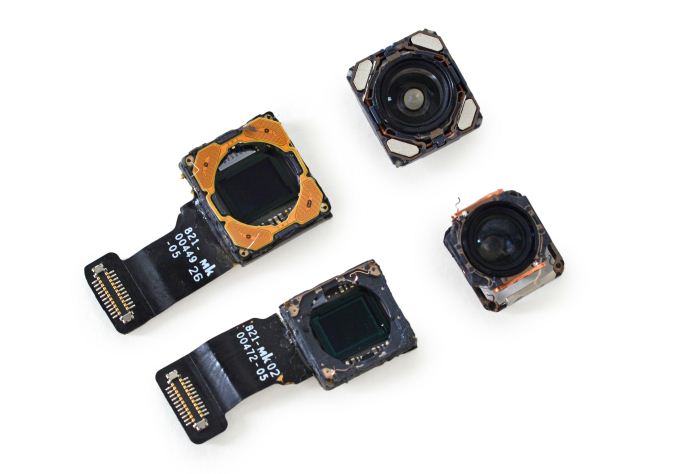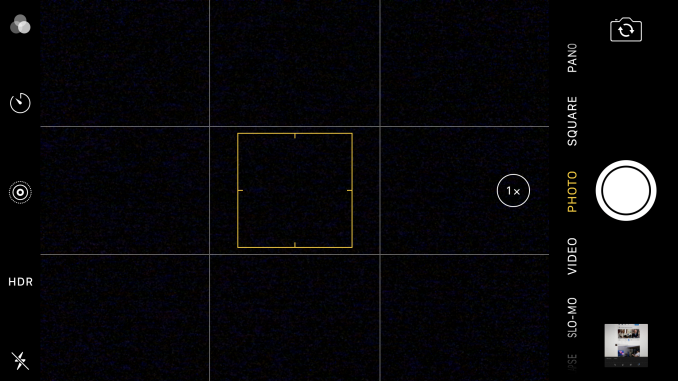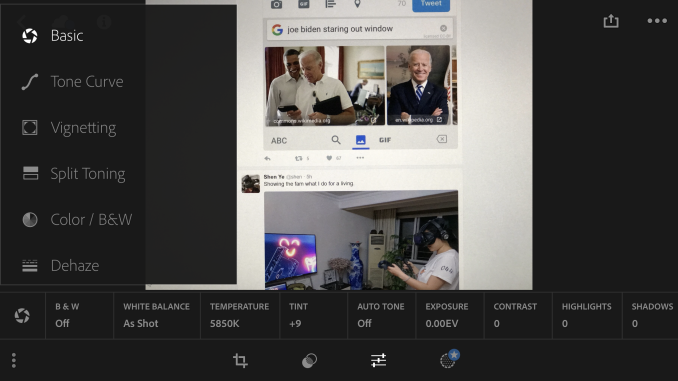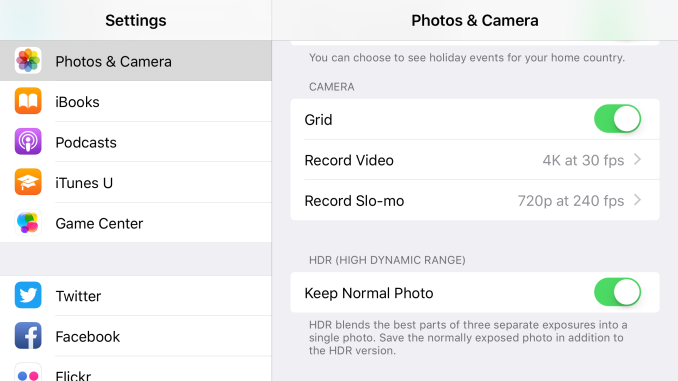The iPhone 7 and iPhone 7 Plus Review: Iterating on a Flagship
by Joshua Ho & Brandon Chester on October 10, 2016 8:00 AM EST- Posted in
- Smartphones
- Apple
- Mobile
- iOS
- iOS 10
- iPhone 7
- iPhone 7 Plus
Camera Architecture
Before we get into the results of the camera output it's always helpful to actually examine the basic characteristics and hardware that make up the camera as a number of characteristics can be predicted or understood by looking at the basic hardware. The CIS technology used can have significant impacts on noise, active area, and a number of other features including slow motion video capture. However, to say that the CIS is the only area worth examination ignores the whole chain of hardware and software needed to make a great camera. With that said we can start our look at the camera with the table below which summarizes a number of high level details for the camera.
| Apple iPhone Cameras | ||||
| Apple iPhone 6s Apple iPhone 6s Plus |
Apple iPhone 7 Apple iPhone 7 Plus |
|||
| Front Camera | 5.0MP | 7MP | ||
| Front Camera - Sensor | Sony ? (1.12 µm, 1/5") |
Sony Exmor RS (1.0 µm, 1/?") |
||
| Front Camera - Focal Length | 2.65mm (31mm eff) | 2.87mm (32mm eff) | ||
| Front Camera - Max Aperture | F/2.2 | F/2.2 | ||
| Rear Camera | 12MP | 12MP | ||
| Rear Camera - Sensor | Sony Exmor RS (1.22 µm, 1/3") |
Sony Exmor RS (1.22 µm, 1/3") |
||
| Rear Camera - Focal Length | 4.15mm (29mm eff) | 4mm (28mm eff) 8mm (56mm eff) Secondary |
||
| Rear Camera - Max Aperture | F/2.2 | F/1.8 F/2.8 Secondary |
||
Looking at the camera of the iPhone 7 in some ways the cadence has changed up a bit. While the iPhone 5s to iPhone 6 transition saw the use of almost identical camera sensor and optics, the iPhone 7 actually changes things up relative to the camera that we saw in the iPhone 6s, likely because the difference between the iPhone 6 and 6s camera was fairly mild in still photos. The iPhone 7 still appears to use a similar sensor on the rear, but with a new set of optics that incorporates a wider aperture. Apple seems to be fighting against serious z-height limitations, so we’re continuing to see a reduction in focal length as the iPhone 7 is now basically comparable to phones like the One M7 with its 28mm equivalent focal length. It’d be interesting to know transmission efficiency which would allow for proper comparisons between generations but considering how most dSLR lenses don't' list these specs it's not a surprise that we don't see this kind of disclosure.

iPhone 7 Plus's dual camera modules (Image Courtesy iFixit)
What isn’t listed on the spec sheet is that the iPhone 7 now has OIS, which is going to be a serious step up in terms of performance for anyone upgrading from the iPhone 6 or 6s. While Apple has some proprietary EIS that allows for really impressive performance despite the lack of OIS, a physical mechanism to compensate for hand shake is going to make for a more effective system in the first place, as it fixes the problem before the photons are captured. Apple continues to use advanced software to enable long exposure without visible blur or hand shake so the addition of OIS shouldn’t have any noticeable drawbacks other than increased shot latency in low light.
Of course, the iPhone 6s Plus already had OIS, so for the iPhone 7 Plus there is a new secondary camera with a focal length that is twice as long as the primary camera. However, the aperture is smaller, which means that in low light the system is going to automatically fall back to the primary camera which is still better in low light as far as I can tell, especially because the second camera lacks OIS. However, in bright daytime conditions the second camera’s longer focal length allows for better portraits and better detail in general. This helps to compensate for the iPhone’s sensor size and z-height limitations, but can only really help in daytime conditions.
Interestingly enough, Apple is actually one of the first OEMs to my knowledge to adopt a 1 micron pixel pitch for a camera sensor, but this is being done for the front-facing camera. I’m kind of curious to know what led to this decision as the optics are probably not going to be able to resolve such a small pixel size. We generally don’t review front-facing cameras but for the people that care about this sort of thing I suspect that the FFC is mostly a sidegrade in the sense that it’s probably going to be used to enable higher resolution video capture rather than higher quality still photos.
Camera UX
As far as the camera application goes, there’s really nothing new this generation. If you’ve taken pictures with a relatively new iPhone, you’re going to be right at home with the iPhone 7’s camera UI. For those that haven’t used a relatively new iPhone before we can do a quick review to discuss what is and isn’t present. At a high level, the UI is split up into a few logical sections, with mode-specific options in their own section. Modal selection is on the opposite side, with text that fairly clearly delineates the purpose of each mode. Below the modal selection, general options are presented for things like changing between front and rear cameras as well as the shutter button and camera roll.
It's hard to really say much about the iPhone camera UI at this point because it’s been polished to the point that there’s really no obvious criticisms to make about it. Apple may have made the mistake of shipping a 16:9 preview for a 4:3 camera before, but it’s been years since glaring issues like that have come up. Tapping to focus allows for either locking focus and exposure or biasing the exposure, which is going to provide coverage for 95% of still image cases. Of course, if you want more fine adjustment the default camera app is going to be inadequate, but there are plenty of good manual camera applications on the market like ProCam, ProShot, and Manual Camera.
It’s worth mentioning that while Apple was far from first to implement RAW capture on smartphones, their implementation is differentiated by a real end to end solution. Something like the HTC 10 really needs Lightroom to bring out the best in its RAW captures, although Snapseed is still reasonably useful in a pinch. Apple is leveraging their ecosystem which allows for things like fully featured Adobe Lightroom for RAW processing. I thought for a very long time that processing RAW was infeasible in the context of a smartphone TDP without fixed-function hardware, so it’s incredibly impressive to see Lightroom working smoothly when processing RAW images.
While most of the camera UX is designed well, one noticeable issue here is that the camera settings are integrated into the settings application rather than the camera application itself. If you’re used to how iOS works this makes sense, but things like resolution settings for video are placed in this menu rather than integrated into the camera application which makes switching between these settings relatively painful if you’re used to something like the HTC 10’s camera UI which places resolution settings in a slide-out drawer. This isn't a huge issue but it's definitely something I noticed due to the need to rapidly switch between resolution settings for video testing. Your mileage may vary here if you don't particularly care for such issues. Overall though, the camera UX has few friction points.













377 Comments
View All Comments
solipsism - Monday, October 10, 2016 - link
So you want legislation to artificially control smartphone prices and kill the free market. Brilliant¡If you graph the supply and demand for the iPhone you'll see that equilibrium price is actually lower than it could be. Meaning, Apple is actually losing money in the short term, but this isn't altruistic, but designed to help capture the market for the longterm, therefore increasing their overall profitshare. Economies of scale are already maxed out at it is.
The cost of components or what you perceive as the value of a smartphone is irrelevant—all that matters is what the market dictates. If you feel that high-end smartphones are too expensive, then don't buy them. They did release an iPhone SE because the market wanted a 4" model. If you and enough others stop buying smartphones in this price range you'll see that ARP drop. This happened in India.
jlabelle2 - Friday, October 14, 2016 - link
"They did release an iPhone SE because the market wanted a 4" model"Not at all. If it was the case, the sales of the iPhone 6 would not have been so huge compared to previous model.
The release the SE because they wanted to target people not willing to spend 750-850$ on a phone. The SE is selling mostly because it is half the price and the cheaper iPhone ever sold.
grayson_carr - Monday, October 10, 2016 - link
The price of iPhones has not risen. What are you talking about?grayson_carr - Monday, October 10, 2016 - link
The first iPhone was originally $599 subsidized with a two year contract, meaning over $1000 were it not for the subsidy, and the base model iPhone 3G was priced much lower at $599 full price without a contract, but that still equates to ~$670 today when you factor in inflation. So at a starting price of $649, the iPhone 7 is cheaper today than iPhones were 8 years ago accounting for inflation.StrangerGuy - Monday, October 10, 2016 - link
I didn't knew owning luxury goods is a fundamental human right.It doesn't matter much you stinkers try to hide your entitlement syndrome under the guise "for the greater good", you still get smelled a million miles away.
kogtsalami - Monday, October 10, 2016 - link
Small correction: The iPhone 4 was not made of aluminium but stainless steel.JoshHo - Tuesday, October 11, 2016 - link
The intent was to say that the iPhone 4 was one of the first smartphones to use external antennas integrated into the design rather than internal antennas embedded in RF windows.dsraa - Monday, October 10, 2016 - link
No mention of the audio performance through the new dongle? what about bluetooth sound?? I know this is a brief review, but at the very least their should be a section on audio and how it compares to the 6s since there it is now done through a digital 'adapter'???TechnologyGuy - Monday, October 10, 2016 - link
Sorry as usual with an iPhone review here - great on the details but illogical conclusions. The removal of 3.5mm headphone jack doesn't matter? That's a clear deal breaker for me, especially when AirPods for me literally belong in the garbage and having invested $1000's on headphones in the past. Not sure what you mean about the camera - iPhones have now barely caught up in quality, but clearly still lagging behind the S7 and Pixel. The iPhone 7 battery life is mediocore at best, and without fast charge or wireless charging - another automatic deal breaker for me. The screen is just passable in comparison to the competition.So really, the only thing that is industry-leading is the SoC, and I think at least for me, that hardly compensates for all the subpar areas. I am not sure why you are so obsessed with the SoC and system performance when the overall experience based on the components (at least those that matter in day-to-day usage - screen, camera, battery life/charging) is no batter than your average $300 phone. My experience with a phone does not depend how good I feel about the SoC under the hood. This phone is a clear no for me and not worth the $650-750 USD.
mrochester - Monday, October 10, 2016 - link
You're forgetting that you need to consider the OS and ecosystem too. A phone isn't just a bunch of hardware components, and it's an OS and software layer too, which is much more important than the hardware anyway.